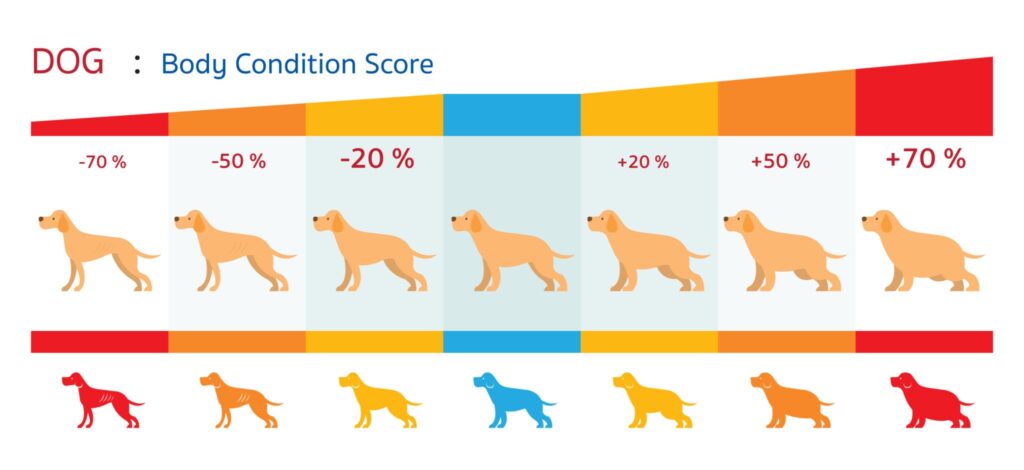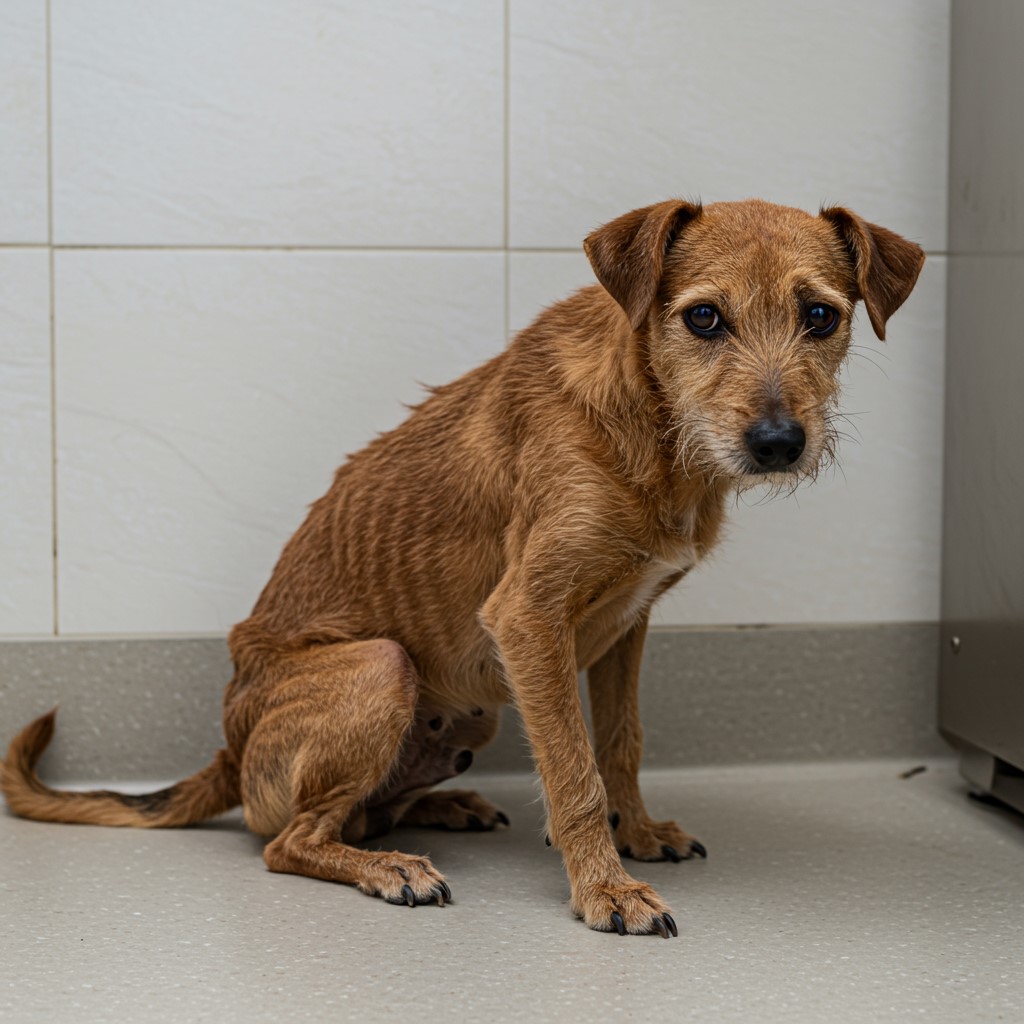Determine your dog’s ideal weight and body condition score (BCS). This tool is essential for managing your dog’s health and preventing obesity-related diseases.
Ideal Dog Weight & Body Condition Score
Determine your dog’s ideal weight and body condition score (BCS). This tool is essential for managing your dog’s health and preventing obesity-related diseases.
Your Dog’s Ideal Weight:
What is a Body Condition Score (BCS)?
A Body Condition Score (BCS) is a simple, non-invasive way to assess if your dog is underweight, overweight, or just right. It’s like a human BMI but tailored for dogs. Veterinarians use a 5-point scale to visually and physically check for fat deposits and muscle mass.[Image of dog body condition score chart]
How to Assess Your Dog’s BCS
- **Feel the Ribs:** Gently run your hands along your dog’s side. In an ideal-weight dog, you should be able to feel the ribs without a heavy layer of fat over them. If you can’t feel them at all, your dog may be overweight.
- **Check the Waist:** Look at your dog from the side and from above. A healthy dog should have a noticeable “tuck” or waistline behind its ribs.
- **Look at the Abdomen:** The abdomen should not be sagging. It should have a slight upward tuck from the rib cage to the hind legs.
Frequently Asked Questions
Why is a healthy weight so important?
Maintaining an ideal weight can add years to your dog’s life. It reduces the risk of serious conditions like arthritis, diabetes, heart disease, and some types of cancer.
What if my dog is a puppy or a senior?
This calculator is primarily for adult dogs. Puppy growth charts and senior dog care plans have unique considerations that are best discussed with your veterinarian.
Ideal Dog Weight & Body Condition Score
Taking care of your dog's weight is one of the most important things you can do to help them live a long, happy, and healthy life. Just like people, dogs can face serious health problems if they are too thin or too heavy. This guide, along with our easy-to-use calculator, will help you understand what a healthy weight looks and feels like for your best friend.
Puppy Growth & Development Tracker
Table of Contents
What is a Body Condition Score (BCS)?
A Body Condition Score (BCS) is a simple way to tell if your dog is at an ideal weight. Think of it as a vet's way of checking if your dog is fit and healthy, without needing a lot of expensive equipment. The score is usually based on a 5-point scale, where a score of 3 is considered "ideal."
- Score 1 (Emaciated): This dog is dangerously thin. You can see and feel all of their bones, including the ribs, spine, and hip bones, with no fat or muscle covering them. The hip bones might be very pointy, and the stomach area is very tucked in. This condition requires immediate veterinary attention.
- Score 2 (Very Thin): The dog's ribs and spine are easy to feel, and their waist is very noticeable. There isn't much fat or muscle on their body. You can see some of their bones easily. While not as dangerous as a Score 1, a dog at this weight should be monitored and may need a diet change.
- Score 3 (Ideal): This is the goal! You can easily feel your dog's ribs without a thick layer of fat, and they have a clear waist when you look at them from above. Their tummy also tucks up neatly when viewed from the side. This is the sign of a healthy, active dog.
- Score 4 (Overweight): It's difficult to feel your dog's ribs because of a layer of fat. They have a less defined waist, and you might see some fat deposits on their lower back and the base of their tail. This is a common score, but it's a sign that diet and exercise changes are needed to prevent future health problems.
- Score 5 (Obese): This dog is very overweight. You can't feel their ribs at all, they have no waist, and you can see large fat deposits on their back and hips. Their belly may be sagging. Being at this score can cause serious health issues and requires a professional weight management plan from a vet.

How to Check Your Dog's BCS
You don't need a vet degree to check your dog's BCS! You can do it at home in a few simple steps.
1. Feel the Ribs
Gently run your hands along your dog's sides, like you're petting them. Use the pads of your fingers and apply light pressure. If your dog is at an ideal weight, you should be able to feel their ribs easily, just under the skin, without a thick layer of fat over them. If you can't feel them at all, they might be overweight. If the ribs stick out too much and are very sharp, they may be underweight.
2. Check the Waist
Look at your dog from above, as if you were looking down on them. A healthy dog should have a noticeable "tuck" or waistline right after their rib cage. It should look like an hourglass shape. If they have a straight or bulging shape instead, they may be carrying extra weight.
3. Look at the Tummy Tuck
Now, look at your dog from the side while they are standing. A dog at an ideal weight will have a slight upward curve or "tuck" from their rib cage to their hind legs. If their belly hangs low and is parallel to the ground, it's a sign they might be overweight.
Why a Healthy Weight is So Important
Keeping your dog at a healthy weight is one of the most effective ways to prevent common health problems. An ideal weight can add years to your dog's life and improve their overall quality of life.
- Joint and Bone Health: Extra weight puts a lot of stress on a dog's joints and bones. This can lead to painful conditions like arthritis, especially in large breeds. Imagine carrying a backpack filled with books all day—that's what excess weight feels like to your dog's joints.
- Diabetes: Overweight dogs are at a much higher risk for developing diabetes, a serious and lifelong illness that requires daily insulin shots and careful diet management.
- Heart Disease: Carrying too much weight makes a dog's heart work harder and can lead to dangerous heart problems. A healthy heart is key to a long and active life.
- Breathing Issues: Extra fat around the neck and chest can make it harder for a dog to breathe, especially in hot weather or during exercise. This can be especially dangerous for breeds with shorter noses, like pugs and bulldogs.
- Reduced Quality of Life: A healthy weight means your dog has more energy to run, play, and enjoy life. Overweight dogs are often less active, have less enthusiasm, and can't do the things they love.
Tips for a Healthier Weight
If your dog is not at an ideal weight, don't worry! There are simple steps you can take to help.
- Measure Food Carefully: Instead of just guessing, use a proper measuring cup or a food scale to make sure you're feeding your dog the correct amount of food at every meal. Even a little extra food each day can add up quickly over time.
- Limit Treats: Treats should only be a small part of your dog's diet, making up no more than 10% of their daily calories. Try using low-calorie options like small pieces of carrots or green beans, or use a portion of their regular kibble as a reward.
- Increase Exercise: Go for longer walks, play fetch, or try new activities like hiking, swimming, or agility. Regular physical activity burns calories and builds muscle, which helps boost their metabolism.
- Talk to Your Vet: Your veterinarian is your best resource. They can help you create a personalized weight management plan, recommend the right food, and give you a specific weight-loss or weight-gain goal for your dog.
The Role of Your Veterinarian
While tools like this calculator can be very helpful, they are not a substitute for professional advice. Your vet can give you a final diagnosis of your dog's health and a plan that is specific to their breed, age, and individual needs. Always consult your vet before making any big changes to your dog's diet or exercise routine.
References
- German, A. J. (2006). The growing problem of obesity in dogs and cats. The Journal of Nutrition, 136(7), 1940S–1946S.
- Laflamme, D. P. (2005). Nutrition for aging dogs and cats and the importance of body condition score. Veterinary Clinics of North America: Small Animal Practice, 35(3), 713–724.
- American Veterinary Medical Association (AVMA). (n.d.). Obesity in Dogs & Cats. Retrieved from https://www.google.com/search?q=https://www.avma.org/resources/pet-owners/petcare/obesity-dogs-cats
- Purina. (n.d.). Body Condition Score: A Key to Your Pet's Health. Retrieved from https://www.google.com/search?q=https://www.purina.co.uk/articles/dogs/health/obesity/dog-body-condition-score
- Kealy, R. D., Lawler, D. F., Ballam, J. M., Mantz, S. L., Biery, D. N., Greeley, E. H., ... & Yamka, R. M. (2002). Effects of diet restriction on life span and age-related changes in dogs. Journal of the American Veterinary Medical Association, 220(9), 1315-1320.
- Lawler, D. F. (2008). The biology and management of aging in dogs. The Veterinary Journal, 178(1), 16-24.

- About Dog Life
- Common Dog Health Concerns
- Dog Breed Selector Quiz
- Dog Calorie Calculator: Find Your Dog's Daily Calorie Needs
- Dog Emergency Guide
- Dog Food Portion Calculator
- Dog Love: Top 10 Dog Loving Nations
- Dog Poisoning Guide
- Forge an Unbreakable Bond: A Guide to Your Dog's Behavior
- HTML sitemap
- Puppy Growth & Development Tracker
- Puppy Training & Socialization Timeline
- Senior Dog Care
- Terms, Conditions & Privacy Policy
- Understanding Your Dog's Language
